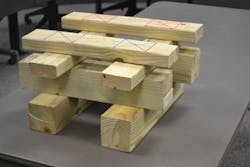University of Extrication: Skills Update: Vehicle Rescue Cribbing
Topic: Cribbing at Vehicle Rescue Incidents
Objective: Understand box-cribbing construction and load capacity.
Task: The rescue team shall understand critical aspects of box-cribbing construction, have the ability to estimate load-carrying capacities, and develop departmental safety guidance for height and angle limitations of box cribbing when used at vehicle rescue incidents.
Within the structural collapse technical rescue field, it is called vertical shoring. Within the vehicle rescue world, it is simply referred to as box cribbing. This University of Extrication Skills Update article presents several teaching points regarding box-cribbing construction, explains how to estimate load-carrying capacities and offers guidance for box-cribbing safety considerations at vehicle rescue scenes.
Teaching points
Load-carrying capacities of box cribbing vary depending upon cribbing dimensions, how the box crib is arranged, and whether the rescue team is using wood or composite plastic cribbing. Wood choices include hardwood, such as oak or maple, and soft wood choices, such as Douglas fir or southern yellow pine. We’ll use soft wood cribbing for our examples here. Rescue teams using hardwood or plastic cribbing can make load-capacity adjustments as appropriate.
The first teaching point with wood cribbing is that the load should be applied to the individual cribbing pieces in what is referred to as “cross grain.” This means that to achieve the best load-carrying capacity, the grain of each wood crib piece should run horizontal (flat). With this placement, the load on the box crib compresses the wood grains together.
Secondly, the cross-grain load-bearing design strength for wood cribbing varies depending on whether it is hard or soft wood and what species of wood is being used. For vehicle rescue purposes, we can accept that the load-bearing capacity per square inch of soft wood cribbing pieces varies from 200 psi to 1,000 psi of load. Responders should consider 500 psi as a guideline for Douglas fir or southern pine cribbing. Hardwood oak or maple cribbing may support as much as three times the capacity of soft wood. Plastic, polyethylene cribbing can sustain from 700 psi up to 1,200 psi.
When cribbing is assembled, it is important that the cribbing on the layer above is placed inward from the edge of the cribbing pieces below. This cribbing overhang pattern allows the stack to stay together under load conditions. In fact, with the ends of the cribbing overhanging the layer below, the ends will actually expand and serve to lock the crib stack together under heavy load.
When a box crib needs to contact a surface that is not flat and horizontal, rescuers might consider slanting the cribbing. For vehicle rescue applications, it may be necessary that a crib stack be slanted or angled using wedges. What is important to note is that there are recommended limitations to how much a box crib can be angled.
In a structural collapse situation, guidelines speak of a maximum slope or angle of 30 degrees for a box crib. For vehicle rescue, crews should attempt to limit that slope of a box crib to less than that, potentially a mere 15 degrees. Since a typical wedge is cut at a 15-degree angle, inserting a pair of wedges into one layer of a box crib should serve as a good safety guideline for keeping the box crib in a safe load condition. The more slant or angle, the more issues present themselves with off-set crib-stack loading.
When establishing safety guidelines for box cribbing height in the structural collapse environment, authorities speak of limiting the height of vertical shoring (box cribbing) to three times the working width or shortest width of the box-crib stack’s “footprint.” There is also guidance to limit the height of a box crib constructed with 4 x 4 wood to 4 feet.
For vehicle rescue situations, however, where crash-damaged vehicles introduce a lot of potential unwanted movement variables, a more restrictive safety recommendation is offered for consideration. For crash scenes, when a box crib constructed of 4 x 4 members reaches a height of two times the length of the cribbing being used, rescuers might want to reconsider their choice of equipment—18-inch cribbing at 3 feet and 24-inch cribbing at 4 feet. Think about it. If a stack of 24-inch long, 4 x 4 cribbing is now up to 4 feet tall, you probably should have gone to a strut system!
In sum
In summary, the crew leader in charge of any cribbing work at a vehicle rescue incident has a lot to consider. Remember to build your cribbing for the anticipated load it will be asked to support. Check for the overhang of your box cribbing and be alert to the height of the stack. If you think it is getting too high, strut it!
Sidebar:
Critical Elements of Box Cribbing for Vehicle Rescue
1) Cross-grain pattern
2) Soft wood design strength of 500 psi
3) Cribbing “overhang”
4) Cribbing angle
5) Cribbing height

Ron Moore
RON MOORE, who is a Firehouse contributing editor, recently retired as a division chief with the McKinney, TX, Fire Department and now serves with Prosper, TX, Fire Rescue. He self-published the Vehicle Rescue 1-2-3 training manual and serves as the forum moderator for the extrication section of Firehouse.com . Moore can be contacted directly at [email protected].






